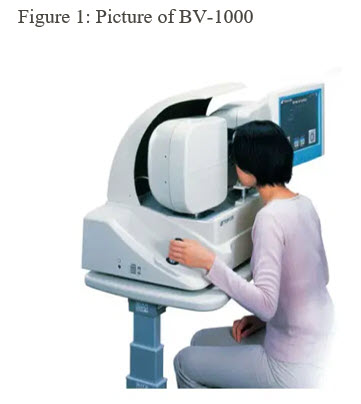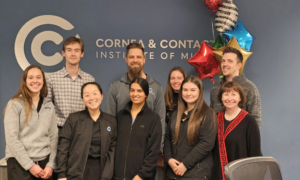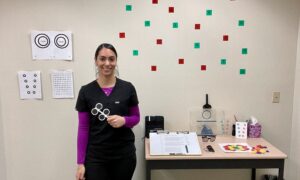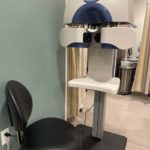
The Chronos refraction system in NECO Center for Eye Care. The technology has a small footprint, and is highly accessible for those with mobility issues. It allows for a more accurate and faster refraction.
By the NECO Innovation Center
Beneath the purview of Gary Y. Chu, OD, MPH, FAAO, Vice-President, Professional Affairs, Timothy Bossie, OD, FAAO, and George Asimellis, PhD.
August 24, 2022
This is the second article of a newly launched channel in Review of Optometric Business, Tech Review. Each quarter, we will publish a review by the New England College of Optometry Innovation Center under the purview of Gary Y. Chu, OD, MPH, FAAO, Vice-President, Professional Affairs, and colleagues, at NECO. The reviews will focus solely on products new to market, which Dr. Chu and his colleagues at NECO have personally learned about, and, in some cases, trialed in the college’s eyecare clinic.
The Topcon Chronos Automated Binocular Refraction System was conceived in the early 2000s by a Topcon employee and subsequently marketed as the BV-1000.1 It was an all-in-one system that was advertised as the world’s first patient-assisted intelligent refraction system because it used a simultaneous binocular autorefractor that allowed patients to be refracted based on voice prompts and interactive responses.2 The idea was to improve the efficiency and accuracy of the refraction process so that clinicians could focus on health assessment and patient education. Being a device that was ahead of its time, it did not catch on and subsequently was discontinued.
At the outset of the pandemic, instrument companies pivoted to rethink how refractive services could be developed in a way to keep patients and doctors safe, as well as provide options for telemedicine. Topcon reimagined the concept of the BV-1000 and developed and launched the Chronos in January 2021.
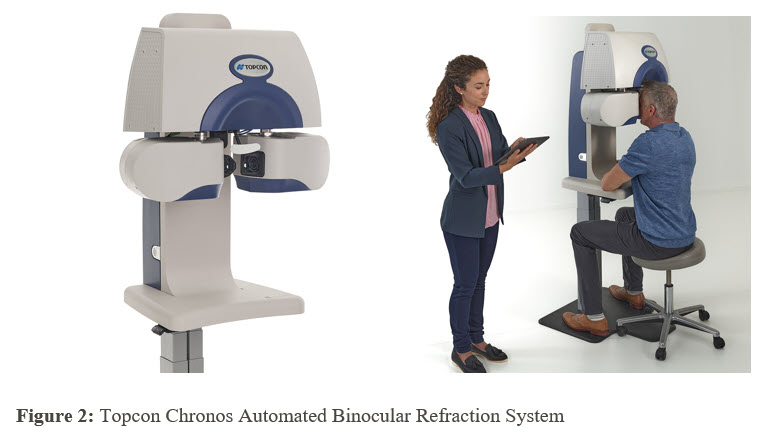
Overview of the Device
Chronos is an all-in-one automated binocular refraction device that combines binocular objective autorefraction measurement, subjective binocular refraction and measurement of visual acuity. It is a free-standing instrument with a small footprint that fits practices with space limitations while allowing clinicians and patients to complete the entire refraction process without moving. Clinical practices use a handheld tablet to choose between two types of refractive programs – traditional phoropter mode or technician mode (via SightPilot).
The tablet control encourages safe distancing between practitioners and patients. Topcon will be launching a remote access option via its ocular telemedicine platform. The initial workflow is similar to their CV5000S digital refractor, which offers a complete binocular subjective refraction or binocular vision testing. For practices using technicians, SightPilot, software that provides a guided, step-by-step approach to refraction, can be activated.
Science of the Technology
Autorefraction, a technology that has been around since the early 1970s, offers the advantage of speedy operation3 and, in many of today’s devices, high accuracy. Currently, there are more than 20 different autorefractors available in the U.S. market. Most operate using a near-infrared beam, and are automated implementations of the Badal principle. They employ auto-alignment, auto-focus and auto-right/left simultaneous measurements. A few systems are fully automatic, using an eye-tracking system, while most operate with a joystick. The Chronos is a fully automated autorefraction system.
Autorefractors can be classified as monocular or binocular, closed- or open-field, and traditional or wavefront-based.4 Binocular or monocular indicates if the binocularity is present or not during the measurement, while closed- or open-field relates to whether the image of fixation is virtual or real.
Other Articles to Explore
Although many autorefractors show a slight overestimation of myopia,5 astigmatism is measured accurately because it is a simple difference between two sphere values that carry a similar bias.6
Despite this “tendency to myopia” limitation, some autorefractor models demonstrate a good agreement with subjective refraction in terms of spherical and cylindrical refractive errors,7,8 especially the binocular open-field traditional autorefractors.9 While the Chronos is a closed field autorefractor, its binocularity avoids the error of proximal accommodation, which has been supported by several comparative studies between such autorefractors and subjective refraction in terms of spherical refractive error.10 In addition, combined with binocular subjective refraction, the Chronos system has delivered accurate results.1
What ODs & Their Staff Think
● How has it been received?
○ It has been mixed, mostly related to the SightPilot software. However, Topcon welcomes feedback and has made continuous adjustments to improve the experience.
○ Initially, excessive eye makeup interfered with autorefractive measurements. This has since been resolved.
○ Based on initial studies done at NECO, refractions have been accurate. Using the SightPilot delegated refraction protocol has also helped students think through the way they refract.
● What types of practice use it?
○ Busy MD/OD practices who delegate refractions
○ Practices with a strong established patient base
○ Practices with limited space
● Ease of use
○ Intuitive and straightforward system in Phoropter and SightPilot mode
○ Set up is easy and uses an intranet that is already included in the system
How the Device Has Been Used in the Office
The combination of having two autorefractors, visual acuity chart and subjective phoropter control within one device is especially useful for practices that have limited space. The accessibility of the device for patients, and the provider’s ability to adjust for each patient, is effortless.
Applying the guided binocular refraction system is useful in environments where technicians have a role in the refraction process. The overall efficiency and ease of use with SightPilot give the clinician more time to educate patients and manage ocular conditions outside of refractive error alone. Additionally, the increased efficiency with refraction gives the clinical practice the ability to add more patients to the schedule since the exam room is freed up.
Through some of NECO’s early experience with the device, Topcon has been receptive to specific feedback provided by faculty or clinicians that could continue to enhance the refractive process with Chronos. With each software version upgrade, there have been noticeable improvements in efficiency, final endpoint refraction accuracy compared to objective measurements and the addition of new testing features. It is important to remember that this device is quite unique in terms of current binocular refractive systems and guided refraction systems, so refinements will continue to be made by Topcon.
This device is well suited for patients who are:
● Not visually impaired or legally blind
● No contraindications such as strabismus or amblyopia
● Not a young child
● Established patients
● Follow-up patients
Final Thoughts
Like many sectors of healthcare, eyecare professionals, industry leaders, scientists and entrepreneurs are rethinking how healthcare services are being provided. Refraction is definitely included in this trend. Topcon’s Chronos Refraction system is a well-thought-out tool in the arsenal of refractive care. It provides eyecare professionals with a robust tool to re-imagine how they may structure their practice to create efficiency and streamline their patient processes in the 21st century. Practitioners must understand this system is not designed to apply to all patients, and must continually evaluate how it may work within their specific practice in order to meet the evolving needs of their patient base.
References
1. Dave T, Fukuma Y. Clinical evaluation of the Topcon BV-1000 automated subjective refraction system. Optometry and vision science. 2004; 81(5):323-33.
2. For Your Patients and Practice. Retrieved from www.optometricmanagement.com/issues/2003/june-2003/what-s-new
3. Rassow B, Wesemann W. Automatic infrared refractors -1984. Ophthalmology 1984; 91 (9 suppl): 10-26.
4. Wosik J, Patrzykont M, Pniewski J. Comparison of refractive error measurements by three different models of autorefractors and subjective refraction in young adults. JOSA A. 2019; 36(4):B1-6.
5. Carracedo Rodríguez JG, Carpena Torres C, Serramito Blanco M, Batres Valderas L. Comparison Between Aberrometry-Based Binocular Refraction and Subjective Refraction. Translational Vision Science & Technology. 2019; 15:05.
6. Reinstein DZ, Archer TJ, Couch D. Accuracy of the WASCA aberrometer refraction compared to manifest refraction in myopia. Journal of Refractive Surgery. 2006; 22(3):268-74.
7. Salmon TO, West RW, Gasser W, Kenmore T. Measurement of refractive errors in young myopes using the COAS Shack-Hartmann aberrometer. Optometry and Vision Science. 2003; 80(1):6-14.
8. Lebow KA, Campbell CE. A comparison of a traditional and wavefront autorefraction. Optometry and Vision Science. 2014; 91(10):1191-8.
9. Mallen EA, Wolffsohn JS, Gilmartin B, Tsujimura S. Clinical evaluation of the Shin‐Nippon SRW‐5000 autorefractor in adults. Ophthalmic and Physiological Optics. 2001; 21(2):101-7.
10. Cleary G, Spalton DJ, Patel PM, Lin PF, Marshall J. Diagnostic accuracy and variability of autorefraction by the Tracey Visual Function Analyzer and the Shin‐Nippon NVision‐K 5001 in relation to subjective refraction. Ophthalmic and Physiological Optics. 2009; 29(2):173-81.

